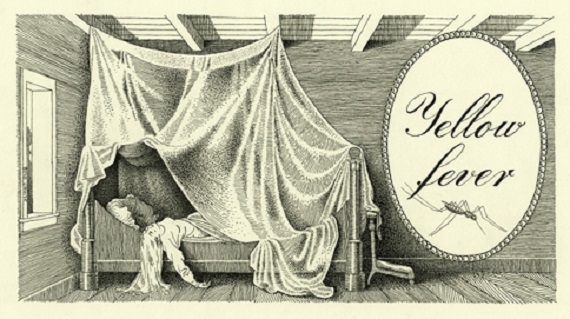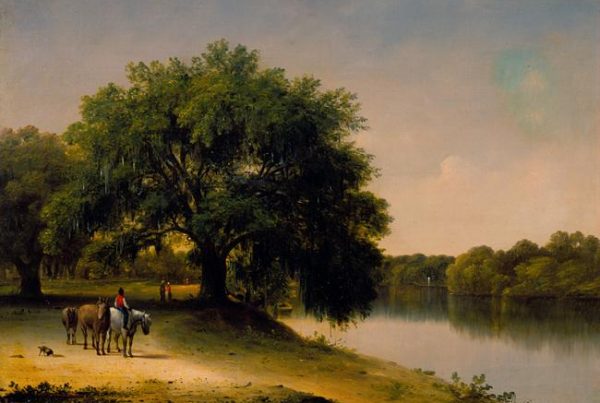While the current worldwide COVID-19 pandemic has also wreaked havoc throughout the South, there was an even more deadly epidemic that attacked a number of Southern states almost a century and a half ago. In the spring of 1878, thousands of refugees from Cuba fled to New Orleans at the end of an unsuccessful ten-year war to gain their independence from Spain. With them, they brought the yellow fever virus that quickly spread through the city. Despite draconian efforts to contain the infection, the disease killed over four thousand people in southern Louisiana before it began its murderous advance up the Mississippi Valley through northern Louisiana, Mississippi and Arkansas . . . and then on to Tennessee where it caused five thousand more deaths before its final invasion of Missouri.
The total death toll in the five states ran as high as twenty thousand, and while that was less than half the approximately forty-five thousand deaths to date from COVID-19 in those same states, the comparison is misleading when you take into consideration the difference between today’s population and that of 1878. There are now about twenty-five million people living in Louisiana, Mississippi, Arkansas, Tennessee and Missouri, which means that the current pandemic has claimed about two lives for every thousand residents. In 1878, however, as there were only a tenth that number of people living in those five states, the death rate would be at least ten times greater than that of today. At that rate, the 1878 death toll in just those five Southern states would equal almost two-thirds of today’s count in the entire United States.
Louisiana, however, was no stranger to the deadly yellow fever virus, with the first epidemic to sweep New Orleans taking place in 1769 when the city was still a Spanish colony. In that year, over six hundred people died and since the colony then had a population of only a little under nine thousand, that meant the rate of death was over seventy per thousand. While other epidemics hit the area again in 1811 and 1817, with the latter also going north to Baton Rouge and reaching as far as Natchez in Mississippi, it was not until the summer of 1853 that the next major outbreak took place. At that time, the disease swept through the entire state, with thirty thousand people falling victim and the taking of over eight thousand lives. During just one day in August, two hundred thirty people died in New Orleans alone, with well over a thousand deaths each week in the sate during that month . . . a staggering death rate of over one hundred per thousand. After 1878, bursts of yellow fever continued to plague Louisiana for more than two decades, with the last major epidemic in New Orleans, as well as in the entire South, taking place in 1905. By that time, however, it had been discovered that the virus was carried by mosquitos and better insect control methods held the death toll to less than five hundred that year.
When the 1878 epidemic began its journey up the Mississippi Valley at the end of August, the officials in Arkansas imposed strict quarantine measures that barred all travel into the state, as well as placing a ban on certain goods, particularly cotton, which they mistakenly feared might be carrying the disease. Even though there were outbreaks of the epidemic in such Arkansas communities as Little Rock, Helena, Hopefield and Augusta, the total number of deaths was only a little over a hundred. Across the river, however, Mississippi was much more seriously effected by the disease, and its passage through the state resulted in well over sixteen thousand cases. The total number of deaths there equaled the four thousand in Louisiana, with almost twelve hundred dying just in the city of Vicksburg.
Next in line was western Tennessee and the city of Memphis, and even though the city had experienced several outbreaks of yellow since 1828, with the last one in 1873 claiming over two thousand lives, the officials were ill prepared for the magnitude of the danger that was fast approaching their city. When reports of the epidemic reached Memphis, over twenty-five thousand residents fled the city and checkpoints were set up in various locations, many manned by armed guards. It was a case of too little, too late however and when the epidemic hit there at the end of August, almost twenty thousand fell ill.
By the time the disease finally left Memphis in mid-October, it had claimed over five thousand lives. Efforts were made to contain the illness within Memphis, and while successful quarantines were established in cities such as Jackson, the communities of Brownsville, Milan, Germantown, Paris, Collierville, Moscow, Martin and LaGrange along the rail lines leading out of Memphis were all hard hit. The epidemic had devastated the economy of Memphis to such an extent that the following year the state legislature revoked the city’s charter. Its white population had also fallen drastically, so much so that black residents were placed on the police force for the first time in the city’s history.
The epidemic made its final journey up the Mississippi River to Missouri where the officials in St. Louis also ordered ships coming up the river to be quarantined, as well as establishing a temporary quarantine hospital north of the city for those who became infected with the disease. A young physician in that city, Dr. Henry Davis, was put in charge of the facility and in September, Davis reported that he had observed a sewage facility near the hospital that was swarming with mosquitos and volunteered to drain it. His action ultimately cost the doctor his life when he became infected with the virus, and it was asserted a half century later that Dr. Davis was actually the first person to identify mosquitos as the carriers of the yellow fever virus. While that claim has never been proven, his service in the fall of 1878 did save many lives, as only sixty-nine people other than Dr. Davis and the nurse who cared for him, Kate McSorley, died in St. Louis during that epidemic.
The epidemic of 1878 in the Mississippi Valley did much to increase medical care in that region, as well as throughout the South, and work began to greatly improve sanitary conditions by installing more adequate sewers and constructing better water supply systems. While such measures did raise overall living conditions in the South, they did not eradicate yellow fever . . . and the actual cause of the virus, mosquitos, while perhaps suspected, was not scientifically proven until the early part of the Twentieth Century.
Even though the yellow fever epidemic of 1878 was the most widespread in the South, there were others earlier that devastated different areas below the Mason-Dixon line, with the earliest being the 1699 Charleston epidemic in the South Carolina Colony that killed three hundred people, which represented fifteen per cent of the city’s population at that time. Even though a third of Charleston’s population then was black, few blacks were stricken and all those who died were white . . . which gave rise to the idea that black Africans had a natural immunity to the disease. Actually, this was partially correct as modern research has revealed that yellow fever had been endemic to Africa for about five thousand years and that the only carrier of the virus, the Aedes aegypti mosquito, was indigenous to that continent. Due to this, many Africans who had survived the disease over the centuries had acquired at least a partial genetic immunity that lessened their chances of contracting the disease and if they did, it reduced the severity of the illness and lowered their mortality rate.
Prior to the 1600s, yellow fever was still unknown in North America but it had been carried to Central and South America in the late Sixteenth Century by Spanish and Portuguese slave ships. Those ships not only brought with them slaves and crew members infected with the virus, but the African mosquitos that would begin to carry the disease throughout the Western Hemisphere. It was not until the mid-Seventeenth Century though that the first epidemics of yellow fever were recorded in the Americas. The first being an outbreak of the disease in 1647 on the the island of Barbados in the Caribbean that took upwards of a hundred lives, with the next on Mexico’s Yucatan Peninsula in 1648. The third event was the more serious epidemic in Cuba that took place from May to October of 1649 that wiped out a third of the population in Havana.
When the first few black Africans were brought to the Virginia Colony from the West Indies in 1619, they apparently were not infected with the virus and since the ships that carried them were English privateers that had not sailed from Africa, it would also seem that no mosquitos were brought with them either. While those first Africans had become indentured servants and, like their white counterparts, had the right to gain their freedom by working off their indenture, within forty years black slavery had largely begun to replace indentured servitude and along with the growing African slave trade came yellow fever.
Sporadic episodes of the disease began to invade the eastern sections of Virginia in the late Seventeenth Century and continued there for almost two hundred years, but it was not until 1855 that the state’s first major epidemics took place. In June of that year, the disease was brought to Portsmouth and Norfolk by the Northern slave ship “Benjamin Franklin” that had sailed into Hampton Roads from the West Indies for repairs. Mosquitos in the ship’s water supply, as well as those infected on board, carried the virus to the dock areas, and by August it had spread to other sections of both cities and infected a large number of the over twenty-five thousand residents. By the end of the epidemic that fall, three thousand people in Norfolk and another thousand in Portsmouth had died.
It should also be added that the slave trade which flourished in all of colonial America during the Eighteenth Century brought both the yellow fever virus and the mosquitos that carried it to the slave ship’s Northern home ports as well. The first epidemic in the North took place in Philadelphia during the summer and fall of 1793 that claimed about five thousand lives. Two of those in the city who contracted the disease but survived were Treasury Secretary Alexander Hamilton and his wife Elizabeth. Even though New York had barred those fleeing the 1793 epidemic in Philadelphia, two years later the virus found its way there and over seven hundred New Yorkers died.
In the summer of 1798, in addition to new epidemics taking place in New York and Philadelphia that killed a total of almost five thousand residents in those two cities, the virus spread even further north in July to the major slave port of Boston where it took another three hundred lives. Two years after the last major outbreak of the disease in the North, it struck again in the South, with a serious epidemic occurring in Baltimore that caused well over a thousand deaths. After 1800, however, most of the yellow fever epidemics were in the lower South.
It was only after the cause of yellow fever had been identified and the virus isolated in the early 1900s that any real effort could be made to find both a cure for the disease and a means to prevent its infection. As with the current novel coronavirus, no fully effective pharmaceutical has yet been found to cure those infected with the yellow fever virus. However, as in the case of COVID-19, a vaccine to prevent yellow fever was developed . . . but instead of the months it took to produce the current vaccines, it took twenty years to introduce an effective one for yellow fever. The first step toward isolating the yellow fever virus and producing a vaccine to combat it was made by the Japanese bacteriologist Hideyo Noguchi in 1918. Noguchi’s vaccine, however, proved to be largely ineffective, and it was not until 1938 that Max Theiler, a South African virologist, managed to correct Noguchi’s mistakes and produce the successful vaccine that is still in use today and has virtually eliminated the disease in all parts of the world except Africa and South America. This achievement won Theiler the Nobel Prize for Medicine in 1951.







Visitor’s Disease. I”ve seen it written that it only affected people not born in the South in the 1800s. Well it did. It’s just that Southern children tended to catch it and it was a milder form when contracted as a child. One Southerner saw it as such a terrible disease that he believed it would win the war for the South when Union soldiers and sailers caught it. It was one pathogen among many parasites and pathogens that tended to fight in the Civil War on one side more than the other most of the time. So I wonder if perhaps it was new residents in the South who came to the South after the Civil War who tended to make up the 1878 epidemic John Marquardt speaks to.